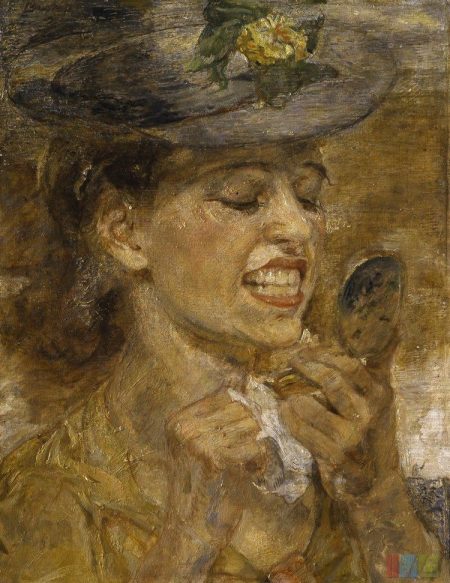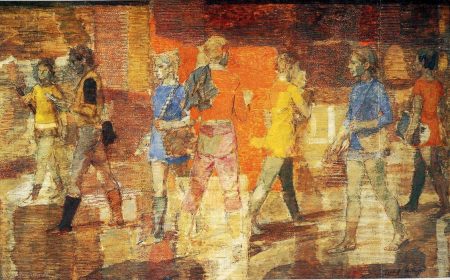Isabel Bishop, born in Cincinnati, Ohio, spent her childhood in Detroit, before moving to New York City to study illustration at the New York School of Applied Design for Women. For many years she had a studio on Union Square at 14th Street, and the Square inspired Bishop with much human activity, which often became her subject matter.
For Bishop, observing and drawing from life was her primary stimulant; the human figure, her primary element of expression. A major theme in her work celebrates the ascendancy of the working woman in the new urban America, documenting the anonymous office girl, alone in a crowd or walking with her girlfriend on their office lunch break.
Bishop was an ardent observer of her casual contemporaries. The pulling on of a coat, tying a sash, eating ice cream cones, blowing smoke rings or standing alluringly at the lunch counter in conversation: such simple episodes string together the hours of the workday. Bishop searches for customs, gestures and affectations that make up the unspoken social etiquette that weaves a cultural identity. Her work is also marked by an honesty, the presence of a real person who converses, dreams and plans, oblivious to a prying gaze. From the late 1930’s to the1960’s, Bishop produced many etchings with aquatint from her pen and ink life drawings. Her painting surfaces are heavily informed by the etching and aquatint techniques of her investigation.
I have always enjoyed viewing examples of her work in person. Two works in the Indianapolis Museum of Art collection exemplify Bishop’s major themes and treatments of contemporary womanhood.

Oil on masonite approx 11″x15″
Collection of Indianapolis Museum of Art
A small but engaging painting is entitled: “Tidying Up”, oil on gesso panel, 1941.
A smartly outfitted young woman has freshly repainted her lips after lunch. Clutching a handkerchief, she checks her flossed and shining teeth for stray lipstick color in her closely held compact. Her nonplused demeanor is accentuated by the stylishly flowered hat, slightly canted over her mascaraed eyes. For anyone who has pursued the experience of drawing people in public, Bishop’s accomplished efforts exhibit a remarkable technical verve that captures a deceptively natural customary gesture.
Bishop made a shift in concept and composition in her later works, painting in oil and tempera on canvas. Departing from the personality component, Bishop investigates form and movement such as walking in an atmospherically infused space. In this transition, Bishop carries the aquatint component forward as an abstracting element on the canvas surface, translating space and atmosphere into multi-linear and textural tonalities.
“Nude Reaching”, oil and tempera on canvas, was executed in the mature period of Bishop’s career, circa1964. The trim female figure with turbaned head reaches forward in a spare studio or bedroom setting. The painted surface is woven with multiple close value ochres and warm greyed oranges, anchored with cool grey masses.
It is a beautiful example of superb draughtsmanship married with multiple painting mediums in a distinctive abstract style. The result is a fresh and original statement that sets apart the figurative work of this American artist in a modern epoch that highly favored the abstract gesture and optical movements.
Isabel Bishop became an outstanding figurative artist sharing an intense interest with Reginald Marsh, the Soyer brothers, Edward Hopper and my late father-in-law, Jack Steele, also of Detroit.
I am inspired by Bishop’s undeterred pursuits in an age that rebuffed figurative work as outmoded and irrelevant to modern cultural tastes. Her informed draughtsmanship is authentically realized in multiple media and unrelenting in her search for her vision in the modern world.
–Marlene Steele
